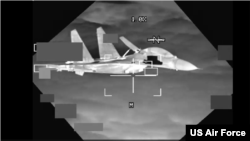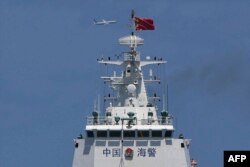On October 26, the U.S. Indo-Pacific Command said a Chinese fighter jet had dangerously intercepted a U.S. Air Force bomber over the South China Sea, coming within three meters of the B-52.
During the intercept, which occurred on October 24, the PRC Shenyang J-11 twin-engine fighter closed on the U.S. aircraft at an “uncontrolled excessive speed…putting both aircraft in danger of a collision,” the U.S. command said.
The U.S. expressed concern that due to limited visibility that night the PRC pilot could have been “unaware of how close he came to causing a collision,” which led to an intercept done “in a manner contrary to international air safety rules and norms.”
When reporters asked the Chinese Ministry of National Defense for pictures or videos of the incident during an October 26 press conference, the ministry released footage completely unrelated to the October 24 incident. It then accused the U.S. of "provocations."
“This video proves that it is the US side that is making provocations, taking risks and muddling the water,” the ministry’s spokesman Wu Qian said.
That is misleading.
The U.S. Indo-Pacific Command said the incident happened in the sky above the South China Sea at night on October 24.
The footage released by China’s Ministry of National Defense showed an August 19 incident in which a U.S. Navy destroyer, the USS Ralph Johnson, encountered a People’s Liberation Army (PLA) naval task group.
The August 19 video is the only evidence China presented to back up its allegations that the U.S. was to blame for the October 24 incident. However, according to the U.S. Pacific Fleet, even that video “proof” did not show the full picture, as the video had been pre-cut to misrepresent the event.
China claimed that the U.S. warship “took several provocative actions such as making a sharp turn and sudden acceleration or deceleration,” thereby “violating” the International Regulations for Preventing Collisions at Sea.
A U.S. Pacific Fleet spokesperson told VOA that China’s description of the incident and the footage are inaccurate:
“The video released by the PRC only shows cropped segments of a 90-minute interaction between multiple PLAN ships and USS Ralph Johnson,” the spokesperson told Polygraph.info.
Nor does the PRC video have anything to do with the October 24 near miss.
Chinese defense ministry spokesperson Wu Qian claimed that the U.S. “came to China’s doorstep to provoke and stir up troubles,” adding: “How is the Chinese military supposed to intercept the U.S. aircraft and warships if they don’t come?”
But the U.S. Pacific Fleet spokesperson pointed out that “all these interactions occurred beyond the territorial water of any nation where international law preserves high seas freedoms of navigation and overflight.”
China argues that under international law, foreign militaries are not allowed to conduct intelligence-gathering activities in its exclusive economic zone. According to the United States, under the U.N. Convention of the Law of the Sea (UNCLOS), “military vessels are permitted to exercise innocent passage in a territorial sea.”
The United Nations Conference on Trade and Development estimated in 2016 that one-third of the world’s maritime shipping passes through the South China Sea, accounting for $3.37 trillion in annual trade. The waters also hold large oil and natural gas reserves, and lucrative fisheries.
China claims almost the entire South China Sea, angering competing claimants like Vietnam, the Philippines, Taiwan, Malaysia and Brunei.
In 2016, the Permanent Court of Arbitration at The Hague ruled against China’s South China Sea claims. The tribunal said that “although Chinese navigators and fishermen, as well as those of other states, had historically made use of the islands in the South China Sea, there was no evidence that China had historically exercised exclusive control over the waters or their resources.”
China rejected the ruling and has been beefing up its military presence in the area.
In 2021, China passed a law authorizing its coast guard to use “all necessary means,” including force, to stop foreign vessels in the South China Sea.
With tensions escalating, there are fears that the South China Sea region is becoming a flashpoint, with potentially serious global consequences.
Tensions again rose on October 22, when a Philippine supply boat and a Chinese Coast Guard vessel collided near Second Thomas Shoal, a disputed area between Beijing and Manila.
The Philippines accused the Chinese Coast Guard ship of carrying out “dangerous blocking maneuvers,” and has filed a diplomatic protest against China. Beijing said the Philippine side is making “infringement and provocations,” and should stop its actions to “avoid further escalation.”
China’s maritime disputes are centuries old, and bullying perceived competitors has historically been one of Beijing’s key tactics for marking territories it claims as its own regardless of international law.






